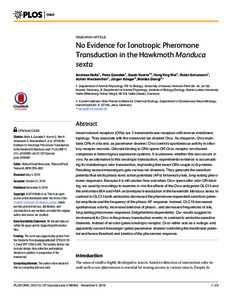Datum
2016-11-09Autor
Nolte, AndreasGawalek, PetraKoerte, SarahWei, Hong YingSchumann, RobinWerckenthin, AchimKrieger, JürgenStengl, MonikaSchlagwort
570 Biowissenschaften, BiologieMetadata
Zur Langanzeige
Aufsatz
Artikel (Publikationen im Open Access gefördert durch die UB)

No Evidence for Ionotropic Pheromone Transduction in the Hawkmoth Manduca sexta
Zusammenfassung
Insect odorant receptors (ORs) are 7-transmembrane receptors with inverse membrane topology. They associate with the conserved ion channel Orco. As chaperon, Orco maintains ORs in cilia and, as pacemaker channel, Orco controls spontaneous activity in olfactory receptor neurons. Odorant binding to ORs opens OR-Orco receptor ion channel complexes in heterologous expression systems. It is unknown, whether this also occurs in vivo. As an alternative to this ionotropic transduction, experimental evidence is accumulating for metabotropic odor transduction, implicating that insect ORs couple to G-proteins. Resulting second messengers gate various ion channels. They generate the sensillum potential that elicits phasic-tonic action potentials (APs) followed by late, long-lasting pheromone responses. Because it is still unclear how and when Orco opens after odor-OR-binding, we used tip recordings to examine in vivo the effects of the Orco antagonist OLC15 and the amilorides MIA and HMA on bombykal transduction in the hawkmoth Manduca sexta. In contrast to OLC15 both amilorides decreased the pheromone-dependent sensillum potential amplitude and the frequency of the phasic AP response. Instead, OLC15 decreased spontaneous activity, increased latencies of phasic-, and decreased frequencies of late, long-lasting pheromone responses Zeitgebertime-dependently. Our results suggest no involvement for Orco in the primary transduction events, in contrast to amiloride-sensitive channels. Instead of an odor-gated ionotropic receptor, Orco rather acts as a voltage- and apparently second messenger-gated pacemaker channel controlling the membrane potential and hence threshold and kinetics of the pheromone response.
Zitierform
In: PLos one. - Lawrence, Kan. : PLoS, 2016, 11 (11), e0166060, 1-23Förderhinweis
Gefördert durch den Publikationsfonds der Universität KasselSammlung(en)
Publikationen (Fachgebiet Tierphysiologie)Artikel (Publikationen im Open Access gefördert durch die UB)
Zitieren
@article{urn:nbn:de:hebis:34-2017062652680,
author={Nolte, Andreas and Gawalek, Petra and Koerte, Sarah and Wei, Hong Ying and Schumann, Robin and Werckenthin, Achim and Krieger, Jürgen and Stengl, Monika},
title={No Evidence for Ionotropic Pheromone Transduction in the Hawkmoth Manduca sexta},
year={2016}
}
0500 Oax 0501 Text $btxt$2rdacontent 0502 Computermedien $bc$2rdacarrier 1100 2016$n2016 1500 1/eng 2050 ##0##urn:nbn:de:hebis:34-2017062652680 3000 Nolte, Andreas 3010 Gawalek, Petra 3010 Koerte, Sarah 3010 Wei, Hong Ying 3010 Schumann, Robin 3010 Werckenthin, Achim 3010 Krieger, Jürgen 3010 Stengl, Monika 4000 No Evidence for Ionotropic Pheromone Transduction in the Hawkmoth Manduca sexta / Nolte, Andreas 4030 4060 Online-Ressource 4085 ##0##=u http://nbn-resolving.de/urn:nbn:de:hebis:34-2017062652680=x R 4204 \$dAufsatz 4170 7136 ##0##urn:nbn:de:hebis:34-2017062652680
<resource xsi:schemaLocation="http://datacite.org/schema/kernel-2.2 http://schema.datacite.org/meta/kernel-2.2/metadata.xsd"> 2017-06-26T09:05:08Z 2017-06-26T09:05:08Z 2016-11-09 1932-6203 urn:nbn:de:hebis:34-2017062652680 http://hdl.handle.net/123456789/2017062652680 Gefördert durch den Publikationsfonds der Universität Kassel eng Urheberrechtlich geschützt https://rightsstatements.org/page/InC/1.0/ 570 No Evidence for Ionotropic Pheromone Transduction in the Hawkmoth Manduca sexta Aufsatz Insect odorant receptors (ORs) are 7-transmembrane receptors with inverse membrane topology. They associate with the conserved ion channel Orco. As chaperon, Orco maintains ORs in cilia and, as pacemaker channel, Orco controls spontaneous activity in olfactory receptor neurons. Odorant binding to ORs opens OR-Orco receptor ion channel complexes in heterologous expression systems. It is unknown, whether this also occurs in vivo. As an alternative to this ionotropic transduction, experimental evidence is accumulating for metabotropic odor transduction, implicating that insect ORs couple to G-proteins. Resulting second messengers gate various ion channels. They generate the sensillum potential that elicits phasic-tonic action potentials (APs) followed by late, long-lasting pheromone responses. Because it is still unclear how and when Orco opens after odor-OR-binding, we used tip recordings to examine in vivo the effects of the Orco antagonist OLC15 and the amilorides MIA and HMA on bombykal transduction in the hawkmoth Manduca sexta. In contrast to OLC15 both amilorides decreased the pheromone-dependent sensillum potential amplitude and the frequency of the phasic AP response. Instead, OLC15 decreased spontaneous activity, increased latencies of phasic-, and decreased frequencies of late, long-lasting pheromone responses Zeitgebertime-dependently. Our results suggest no involvement for Orco in the primary transduction events, in contrast to amiloride-sensitive channels. Instead of an odor-gated ionotropic receptor, Orco rather acts as a voltage- and apparently second messenger-gated pacemaker channel controlling the membrane potential and hence threshold and kinetics of the pheromone response. open access In: PLos one. - Lawrence, Kan. : PLoS, 2016, 11 (11), e0166060, 1-23 Nolte, Andreas Gawalek, Petra Koerte, Sarah Wei, Hong Ying Schumann, Robin Werckenthin, Achim Krieger, Jürgen Stengl, Monika doi:10.1371/journal.pone.0166060 </resource>
Die folgenden Lizenzbestimmungen sind mit dieser Ressource verbunden:
Urheberrechtlich geschützt

